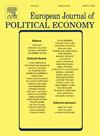The effect of international sanctions on the size of the middle class in Iran
IF 2.4
3区 经济学
Q2 ECONOMICS
引用次数: 0
Abstract
This study examines the impact of international economic sanctions, imposed on Iran due to its nuclear program, on the development of its middle class. Specifically, it investigates how Iran's middle class would have evolved absent sanctions post-2012. Using the Synthetic Control Method (SCM) with nested optimization, we construct a counterfactual scenario for Iran based on a weighted average of comparable countries that mirror pre-2012 Iran but without significant sanctions. Our SCM results indicate that sanctions led to an average annual reduction of 17 percentage points in the size of Iran's middle class from 2012 to 2019. Our Synthetic Difference-in-Differences (SDID) analysis, however, provides a more conservative estimate of a 12 percentage points average annual loss, reinforcing the robustness of the findings. These estimates capture the total effect of sanctions, encompassing both their direct economic shocks, and Iran's policy responses. These results are validated through extensive sensitivity checks, including in-space and in-time placebo tests, leave-one-out analyses, and bias-corrected SCM. We also identify real GDP per capita, merchandise imports and exports, investment, industry value added, informal and vulnerable employment as key channels through which sanctions negatively impact the middle class.
国际制裁对伊朗中产阶级规模的影响
这项研究考察了因伊朗核计划而对其实施的国际经济制裁对其中产阶级发展的影响。具体来说,它调查了2012年后如果没有制裁,伊朗的中产阶级会如何发展。使用嵌套优化的综合控制方法(SCM),我们基于2012年之前的伊朗但没有重大制裁的可比国家的加权平均值,为伊朗构建了一个反事实情景。我们的SCM结果表明,从2012年到2019年,制裁导致伊朗中产阶级的规模平均每年减少17个百分点。然而,我们的综合差异分析(SDID)提供了一个更保守的估计,即平均每年损失12个百分点,加强了研究结果的稳健性。这些估计反映了制裁的总体影响,既包括直接的经济冲击,也包括伊朗的政策反应。这些结果通过广泛的灵敏度检查得到验证,包括空间和时间上的安慰剂测试、遗漏分析和偏差校正SCM。我们还指出,实际人均GDP、商品进出口、投资、工业增加值、非正规就业和弱势就业是制裁对中产阶级产生负面影响的主要渠道。
本文章由计算机程序翻译,如有差异,请以英文原文为准。
求助全文
约1分钟内获得全文
求助全文
来源期刊

European Journal of Political Economy
Multiple-
CiteScore
3.40
自引率
10.00%
发文量
106
期刊介绍:
The aim of the European Journal of Political Economy is to disseminate original theoretical and empirical research on economic phenomena within a scope that encompasses collective decision making, political behavior, and the role of institutions. Contributions are invited from the international community of researchers. Manuscripts must be published in English. Starting 2008, the European Journal of Political Economy is indexed in the Social Sciences Citation Index published by Thomson Scientific (formerly ISI).
 求助内容:
求助内容: 应助结果提醒方式:
应助结果提醒方式:


